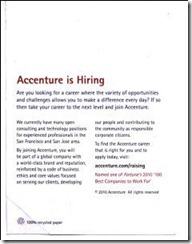HBR has an online article and discussion on “Strategy's Case against Specialization”, that, while (oddly) inspired by a dead poet, makes a good case for NOT developing your strategy in a vacuum by a group of wonks. This reminded me of all the stories I hear about HR leaders doing off-site meetings to develop company HR strategy…entirely removed from business leaders, which makes it at least partially in a vacuum. The article talks about three ways to avoid this issue, which I’m paraphrasing here into strategic workforce planning terms (remembering that strategic workforce planning IS the systematic development of better HR strategy):
Look for the "connection of the week." …At the least, tax yourself each week with thinking up one way, or maybe two, in which seemingly unconnected aspects of your operation just might be connected.
The connections which are most commonly missing or overlooked in workforce planning are data connections which demonstrate the line of sight between HR actions/strategy and business results. If you can think of one per week, you’ll be building a really valuable set of things to measure and align. Our software already has a slew of these defined, but if you don’t have that, at least start building yourself a list! Golden rule: these links are NOT all made of workforce data!
Have a council, a committee, maybe just a standing meeting that brings together different specialties to take action on an issue of collective concern. And not something unimportant, like "Where are we going to hold the company picnic?" Some problem that's keeping you, and possibly them, up at night.
See the key italicization there? DIFFERENT SPECIALTIES. Your workforce planning steering council need to be made up of people who are primarily not in HR. It’s a great opportunity for high-po’s, and for engaged leaders, especially those with lighthouse characteristics.
Reflect on your organization's history, and the possible lessons it contains. Time has a way of suggesting links, forces at work, dynamics that may not have been apparent to the poor souls caught up in the maelstrom of the moment. I know what you're thinking: it's so different today; we can't do things like we used to; and besides, we packaged out all the old timers. Still, your original corporate DNA probably continues to be at work somewhere in there, shaping your response to the fresh hell that confronts you. Try to lift the strands into consciousness, and to put to use any wisdom you find there. It may be preservative, and not for specialists.
So I didn’t even edit this – it’s very true…but we need to also be careful that we don’t live entirely in the past, with historical data and “how we’ve always done it”. Scenario planning and other techniques can help people who aren’t strategy or futuring specialists break the paradigm…but what we do must be squarely rooted in the reality of our organization and history, not some best practice fantasy!
These are only three of many ways to prevent too much specialization. How do you prevent yourself from developing HR strategy in a vacuum?


